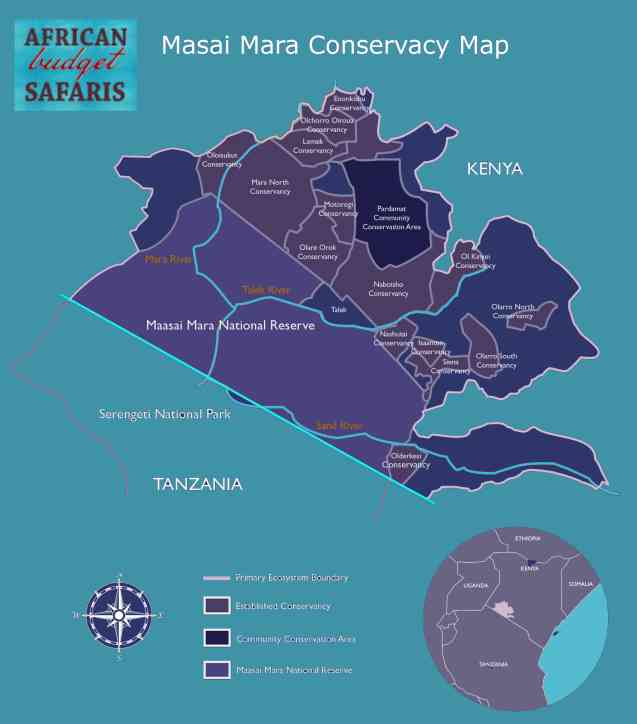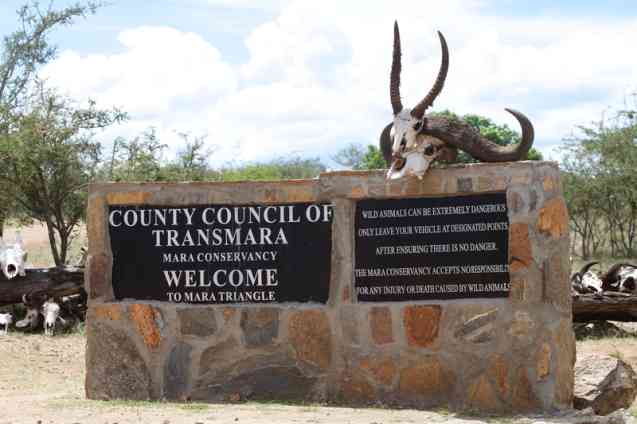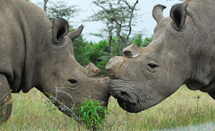The Pros and Cons of a safari in Kenya’s Masai Mara Conservancies
The Masai Mara National Reserve is the #1 safari destination in Kenya (if not Africa). Did you know that the National Park is unfenced and bordered by an area of community-owned conservancies of almost equal size? Kenya’s Masai Mara Conservancies are an interesting and innovative conservation solution that is growing in popularity and delivering world-class safaris. But what are they? What is the difference between the Mara Triangle and the Masai Mara Conservancies and how does a Masai Mara Conservancy safari differ from a safari in the Masai Mara National Reserve?
The Masai Mara Conservancies in Kenya
Kenya’s Masai Mara conservancies are located on the edges of the Masai Mara National Reserve to the north, northeast, and east. Made up of 1450 km² (about 900.99 mi²) of land that is owned by over 14500 Masai landowners, the expansion of the National Reserve to surrounding conservancies has been a conservation game changer.
The concessions are leased by local Maasai communities to private safari companies and are serviced by tented camps which share traversing rights. The conservancies are independently run and adhere to a different set of rules and regulations than those of the National Park which is under Narok County government administration.
The conservancies vary in size from the biggest, Mara North Conservancy at 69,160 acres (over 280 km²) to the smallest, Enonkishu Conservancy which is 5,928 acres (about 24 km²). They encompass various safari landscapes from classic savannah and acacia woodland to riverine bush and rolling rocky hills. Each conservancy has its own unique flavour.
“Our mission is to conserve the greater Mara ecosystem through a network of protected areas (conservancies and conservation areas) for the benefit of biodiversity and wildlife, the local Mara population, and Kenya’s recreation and tourism.” Maasai Mara Wildlife Conservancies Association (MMWCA)
The conservancies share the values of low-impact tourism, conservation, community development, and upliftment. It is useful to remember that 65% of the wildlife in Kenya lives outside of National Parks like Amboseli, Samburu, and the Masai Mara. This means a high incidence of human-wildlife conflict around land usage. The conservancy model successfully addresses this issue by illustrating the socio-economic value of wildlife through tourism.
 Masai Mara Conservancies Map of Kenya
Masai Mara Conservancies Map of Kenya
Masai Mara National Reserve Safari vs Masai Mara Conservancy Safari
The Masai Mara National Reserve is the jewel in Kenya's safari crown. Sharing a border with Tanzania's Serengeti National Park, the Masai Mara National Reserve is government-owned and run. This means that between the Masai Mara National Park and the Masai Mara Conservancies, there are different rules and regulations which affect everything from game management and tourist numbers to safari activities.
Tourist Numbers: Masai Mara Reserve vs Masai Mara Conservancy
The Masai Mara National Park is accessible through the main gate for a fee of between US$70 and US$80 per person. There are no restrictions on the number of visitors to the park. There are also no restrictions on safari vehicles at game sightings like the Mara River crossing or a lion kill. The result of this is that during the peak season, July to October when the wildebeest migration is in full swing, activity around wildlife can resemble a melee. The park gets crowded as do sightings.
The privately-run Masai Mara Conservancies subscribe to a low-impact tourism model. Visitor numbers are strictly controlled and the conservancies aim for around 1 tent per 700 acres of land. In addition to this, within the Mara Conservancies, only 5 safari vehicles are allowed at game sightings. The result is a much more intimate and exclusive African safari experience.
 Masai Mara Elephant, Kenya Safari
Masai Mara Elephant, Kenya Safari
Safari Activities: Masai Mara Conservancy vs Masai Mara Reserve
The large number of guests that visit the Masai Mara National Reserve has resulted in some stricter rules around park usage. There are no off-road safaris, no nighttime game drives, and bush walks are strictly prohibited.
Because Kenya's Mara Conservancies are privately run and have lower tourist numbers, they allow more intimate experiences. If you are looking to do a safari bush walk, a nighttime safari drive, or do some off-road game viewing then the Masai Mara Conservancies are for you. In addition to these activities, some conservancies are offering horse riding and mountain biking.
It is possible to do Hot Air Balloon rides from either the National Park or the private conservancies but your transport times from the outlying conservancies to the fixed launch sites will be longer.
 Wildebeest Migration River Crossing, Masai Mara
Wildebeest Migration River Crossing, Masai Mara
What about the Great Wildebeest Migration?
The Wildebeest Migration (aka Great Migration) is one of the top reasons people flock to the Masai Mara yearly. In this regard, being in the Masai Mara National Reserve puts you closer to the Great Migration's river crossing points on the Mara and Talek Rivers. This is where the Masai Mara National Reserve holds the trump card. The trade-off however is the large volumes of fellow safari enthusiasts.
Many people opt for a mixed destination option. They stay in the greater Masai Mara Conservancies for the exclusive feel and then visit the National Park on day safaris or spend a night or two there taking advantage of the proximity to the Mara River and the hot-air balloon launching sites. This is seen as the best of both worlds and means you won’t miss out on that special bucket list item.
Wildlife: Masai Mara National Reserve vs Masai Mara Conservancies
What is the difference between wildlife in the Masai Mara National Reserve and Masai Mara Conservancies? The simplest answer is not much. Because the conservancies are contiguous with the National Park, wildlife is free to roam where and how they will. The big difference will be the number of safari goers you encounter on your Kenya safari. You must enter the Masai Mara National Reserve to see the full scale of the Great Migration and Mara River crossings but other than this, both National Park and Conservancies are brilliant year-round safari destinations.
Accommodation: Masai Mara vs Masai Mara Conservancy
The Masai Mara National Park has over 5000 beds available during the peak season. Accommodation ranges from lodges to basic tented camps but as a general rule are seen as more affordable as they cater to the masses.
The conservancies, limiting their guest numbers to 1 per 350 acres in order to reduce the impact on wildlife and the environment, only offer around 1 camp per 700 acres. Because of these restrictions on numbers, the conservancies tend to be more expensive and more in demand.
| Masai Mara National Reserve | Masai Mara Conservancy |
|---|---|
|
|
Community & Maasai Culture
Another major difference between the Masai Mara National Park and the Masai Mara Conservancies is the role played by the local Maasai people.
Within the National Park, there are no Maasai Villages, and cattle grazing is forbidden. The wildlife conservancies on the other hand have, over time, been rehabilitated from pastoral usage back to the wild. While some areas are exclusively set aside for wildlife, other areas are for mixed usage. The Maasai people are therefore an integral part of the environment and these close links are part of what makes the Masai Mara Conservancies so special. Remember, there are no fences surrounding the Masai Mara National Park or any of the conservancies. Wildlife big and small can roam freely and when you do find a fence, it is more likely to keep the game out rather than fence wildlife in.
Many of the staff employed by the safari operators come from local communities. Visits to local villages will often end up being visits to their homes. The positive implication is that these are not tourist villages set up for the entertainment of foreign guests but rather an opportunity to get a real glimpse of this vibrant Maasai culture and practices.
When visiting the Masai Mara Conservancies on an African safari, you are directly benefiting the local people and helping to improve their lives.
Masai Mara Conservancy Safari vs Mara Triangle Safari
The Mara Triangle is the unfenced westerly wedge of the National Reserve. Its borders are formed by the Mara River to the east and the Oloololo Escarpment to the northwest and Tanzania's Serengeti to the southwest. Though owned by the Masai Mara National Reserve, since 2001, the Mara Triangle has been run and managed by the non-profit Masai Mara Conservancy. This means that the Mara Triangle is a hybrid between the government-run and conservancy models.
The Mara Triangle is also the hotspot of the Great Migration action as this is where the migratory herds of ungulates enter the Masai Mara from the Serengeti in Tanzania. The crowning highlight of any Kenya safari is seeing the Mara River crossing. The benefit of this arrangement is that within the Mara Triangle, it is possible to escape the congestion that accompanies the high season east of the river.
| Masai Mara Conservancy Pros | Masai Mara Conservancy Cons |
|---|---|
|
|
Why Choose a Masai Mara Conservancy?
The big drawcard of the Masai Mara Conservancies is the intimate safari experience and the sense of exclusivity. However, the direct community and conservation benefits make choosing the Masai Mara Conservancies an easy choice.
The Masai Mara Conservancies subscribe to a low-impact tourist model. Tourist numbers are tightly controlled and vehicle numbers at wildlife sightings are restricted. The result of these restrictions is a much more exclusive and intimate safari experience. Wildlife within the conservancies is often more abundant, the theory being that they seek refuge in the less busy outer reaches of the Masai Mara ecosystem. There are no fences between the National Park and the conservancies.
Income generated through safari tourism benefits the local communities directly which in turn benefits conservation efforts. Staff and rangers are often recruited directly from within the local communities. The positive spinoff is that you are likely to have better cultural interactions with local Maasai even though the language barrier might be a little higher! Being with the people on their land adds an element of authenticity that can be further enhanced by taking advantage of organized 'cultural visits' to nearby Maasai villages (these are always purely optional).
Ready to Book Your Masai Mara Conservancy Safari?
You can visit the Masai Mara Conservancies year-round but to avoid disappointment around the Wildebeest Great Migration, the earlier you book the better.
Take a look at our affordable Masai Mara Conservancy Safaris, or if you are ready to take the next step towards realizing your Kenya safari adventure, talk to one of our African safari experts today.
If you liked this post, these trips cover similar ground…
- 3 Day Fly-in Masai Mara Safari to Exclusive Camp
- 4 Day Fly-in Masai Mara Safari in Kenya - Tented Camping
- Budget Kenya Safari: Masai Mara Lodge Tour
- Budget Kenya Safari - Masai Mara & Beyond
- 5 Day Fly-in Kenya Safari in Masai Mara Conservancy Areas
- Kenya Budget Safari - Masai Mara & Best Parks Lodge Tour
- 8 Day Kenya Family Safari to Masai Mara Lodge & More
- Kenya Safari: Masai Mara, Tsavo & Amboseli
- 10 Day Kenya to Tanzania Tour - Best Parks, Masai Mara & Serengeti Safari
- Tanzania & Kenya Safari: Masai Mara, Ngorongoro & Serengeti Lodges
- Northern Kenya National Parks & Masai Mara Safari











 On the outskirts of Marloth Nature Reserve, Andrew can be found walking and swimming in the beautiful Langeburg Mountains. He is passionate about animals, birds, reptiles, and plants and loves nothing more than an adventure in nature. An established artist with a master's in English literature, Andrew has traveled far and wide but South Africa still has his heart.
On the outskirts of Marloth Nature Reserve, Andrew can be found walking and swimming in the beautiful Langeburg Mountains. He is passionate about animals, birds, reptiles, and plants and loves nothing more than an adventure in nature. An established artist with a master's in English literature, Andrew has traveled far and wide but South Africa still has his heart.












